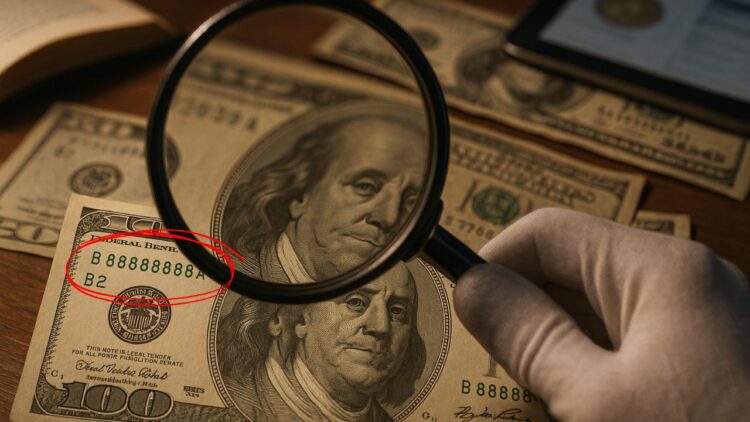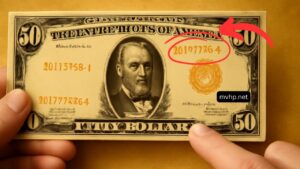In the world of currency collecting, certain serial numbers can transform an ordinary bill into a highly coveted item.
Among these, the 1996 $100 Federal Reserve Notes featuring repeating 8s have garnered significant attention in 2025. Their rarity, coupled with the allure of repeating patterns, has made them a hot commodity among collectors and investors alike.
Understanding Serial Number Variations
Before delving into the specifics of the 1996 $100 bills with repeating 8s, it’s essential to understand the different types of serial numbers that collectors find valuable:
- Repeater Serial Numbers: These consist of two identical four-digit sequences, such as 12341234.
- Radar Serial Numbers: These are palindromic, reading the same forwards and backwards, like 1234321.
- Solid Serial Numbers: Comprising the same digit repeated, such as 88888888.
- Super Repeater Serial Numbers: Featuring a two-digit sequence repeated four times, like 12121212.
- Ladder Serial Numbers: Numbers that ascend or descend in a sequence, such as 12345678 or 87654321.
Among these, the solid serial number 88888888 is particularly rare and highly prized.
The 1996 $100 Bill: A Collector’s Perspective
Series and Design
The 1996 series $100 bill, also known as the Series 1996 Federal Reserve Note, was part of the U.S. government’s redesign of currency to enhance security features.
These notes were printed under the signatures of Treasury Secretary Robert E. Rubin and Treasurer of the United States Kathleen B. Withrow.
The design retained the portrait of Benjamin Franklin and the image of Independence Hall, with added security features like a security thread and a watermark.
Serial Number Structure
Each $100 bill has a unique serial number composed of eight digits and a letter prefix. The serial number is printed twice on the front of the bill, once in the upper-left corner and once in the lower-right corner. For example, a bill might have the serial number “AB 12345678 A.”
Why Are Repeating 8s So Valuable?
Rarity
The occurrence of a solid serial number like 88888888 is extremely rare. Given that each bill has a unique serial number, the probability of a specific sequence repeating eight times is minuscule. This rarity makes such bills highly desirable among collectors.
Collector Demand
Collectors often seek out bills with unique or aesthetically pleasing serial numbers. Repeating numbers, especially those like 88888888, are considered lucky and are associated with prosperity in various cultures. This cultural significance adds to their appeal and, consequently, their value.
Investment Potential
As with any rare collectible, the value of bills with repeating 8s can appreciate over time. Collectors and investors view these bills not only as items of interest but also as potential assets that could yield a return on investment.
Market Value in 2025
The market value of a 1996 $100 bill with a repeating 8 serial number can vary based on its condition, certification, and demand.
While specific auction results fluctuate, such bills have been known to sell for several hundred dollars, with some reaching over a thousand dollars in uncirculated and certified conditions.
Value Estimates for 1996 $100 Bills with Repeating 8s
| Condition | Estimated Value |
|---|---|
| Circulated | $200 – $400 |
| Uncirculated | $500 – $800 |
| Certified (e.g., PMG 65) | $1,000+ |
How to Identify and Authenticate
Identification Tips
- Serial Number: Look for bills with the serial number 88888888.
- Condition: Examine the bill for folds, creases, or discoloration. Uncirculated bills are more valuable.
- Security Features: Ensure the bill has all the standard security features, such as a security thread and watermark.
Authentication
To authenticate a bill, consider the following steps:
- Professional Grading: Submit the bill to a reputable grading service like PMG or PCGS for certification.
- Expert Consultation: Consult with currency experts or numismatists who can verify the bill’s authenticity.
- Market Comparison: Compare the bill with similar authenticated bills in the market to assess its value.
The 1996 $100 bill with a repeating 8 serial number stands out as a rare and valuable item in the world of currency collecting. Its rarity, coupled with cultural significance and collector demand, has propelled its status in 2025.
For collectors and investors, possessing such a bill is not just about owning a piece of currency but holding a tangible asset that embodies both historical and cultural value.
FAQs
Are all 1996 $100 bills with repeating 8s valuable?
Not necessarily. The value depends on factors like condition, certification, and market demand. Uncirculated and certified bills are typically more valuable.
How can I sell my 1996 $100 bill with a repeating 8 serial number?
You can sell it through online auction platforms, currency dealers, or numismatic conventions. Ensure you have proper authentication and documentation to maximize its value.
Can the value of my bill increase over time?
Yes, like other collectibles, the value of rare currency can appreciate over time, especially if demand increases and the bill remains in good condition.




